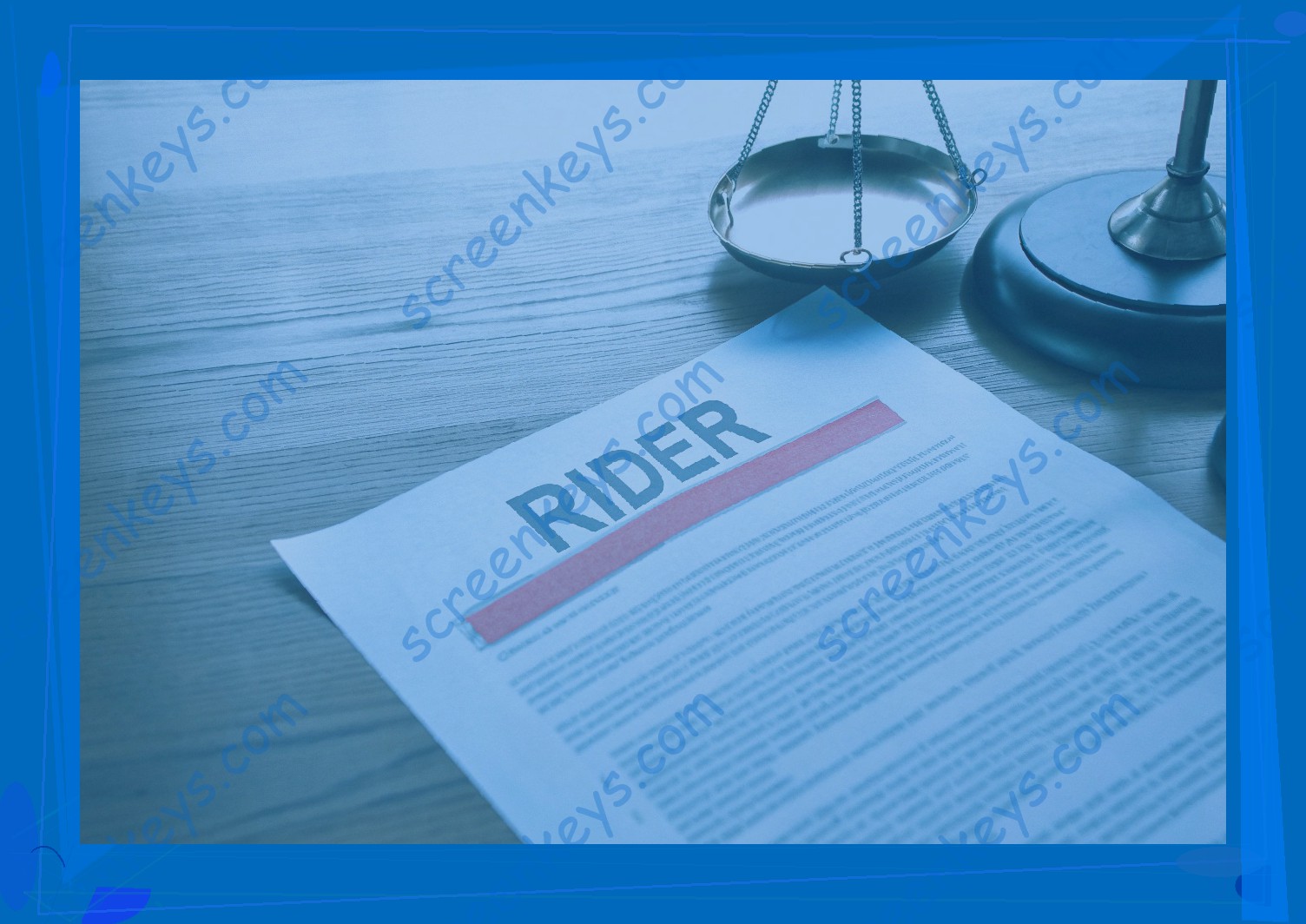What is a rider in contract?
A rider is effectively a special provision or addendum that is written into the existing body of a contract. Sometimes referred to as an amendment, riders can frequently be used to modify payments and other schedule terms, such as the overall time for completion of an agreement. The rider should become part of the document by way of reference, which indicates the original offer and acceptance also pertain to the rider. A rider cannot be requested unilaterally and must be agreeable to both parties. It does however provide an alternative way to adding amendments to the contract on or near the date of execution.
While riders are similar to amending documents , it should be noted that the intention of a rider is to add information, such as additional consideration. This is one of the reasons why a rider is recognized as a stand-alone document, which is considered to be distinct from the original contract. For instance, on rare occasions a rider may be a document that has nothing to do with the original agreement, but adds either a business transaction or component that is not contained in the initial proposal.
Common riders
Financial riders might cover the earnings percentage a talent will receive from sponsorships, endorsements, or licensing of their name, visual image, or performance. An insurance rider might be added to a contract that would set forth the obligations of the parties with respect to the insurance that will be maintained for the benefit of each and that provides more extensive coverage than the standard provisions in the contract. A management rider might allow the manager to represent any new companies a client has an affiliation with. It might extend the expiration date of the management agreement and possibly increase fees to the manager if the manager books a profitable gig or increases sales of a product or service. An entertainment rider likely will set forth requirements for the performance itself such as sound and lighting or how and to whom the entertainer will be paid. An entertainment rider could be a rider for a film engagement that sets forth the actor’s approvals over costs of wardrobe and travel as well as approvals over the script, other actors and direction.
The significance of a rider
Riders can add additional details and clarifications to an agreement, which is ultimately important when it comes to protecting all parties. A rider specifies certain terms or provisions that are not included in the main contract. If you are hiring someone to perform a service, you likely want the person taking the job to understand exactly what is covered. For example, if your agreement says that your consultant will charge $120 per hour, but the scope of work you want from them and the level of detail you expect was not clear, it could lead to frustration and confusion. Perhaps you were expecting them to help you with a full marketing strategy, but they thought you wanted a few blog posts. By using a rider, you could make it very clear that you are looking for an extensive plan that includes emails, a business plan, and a number of other marketing activities.
Riders can only add detail that is not already in the contract. Therefore, if you have already addressed an issue in your contract, a rider is not the best place for it. Contracts are binding legal agreements, so you should be careful how and where you apply specifics. Be sure to only put supplemental information that you believe is important, and assess what your specific contract needs, as a new rider agreement will not necessarily be needed for every contract.
How to write a contract rider
A rider is a prerequisite to drafting a contract that requires detailed, specific, and unique terms. Rather than simply filling in the blanks of an agreement already prepared by your attorney, a rider gives your lawyer a chance to draft a custom agreement that takes into account all of your unique circumstances and legal risks.
For example, if you are thinking about lending money to a friend or starting a new business with a partner, you may be tempted to ignore sound legal advice and simply draft a written agreement. However, without consulting an attorney, you may overlook key considerations when drafting such an agreement. In fact, many people fail to realize that a contract, even a very detailed one, is only as good as the enforceability or interpretation of its various provisions. You may know what a particular provision of the contract means in your own mind, but will a judge? If not, there is a real risk that a court could completely ignore important provisions.
Drafting a contract rider is as easy as 1-2-3. And drafting an enforceable rider is as easy as ABC:
- Be specific. The more detail you include in the contract, the less likely you need any "legalese" (unnecessary legal jargon.) Remember that a contract should not only reflect your intentions as the parties, but you must reduce such intentions to a legally adequate writing for the contract to be enforceable. It is better to more than less, but always be specific.
- Don’t Try to Do it All. It is possible that a contract rider may actually require additional riders to provide necessary detail and to clarify additional issues. For example, for a contract that requires a buyer to guarantee seller a minimum profit, both parties may want to consider a "sales" rider and a "profit margin" rider. In addition, if any of a seller’s goods are manufactured overseas, the parties may want to consider considering a free trade rider or a tariff rider.
- Finally, go beyond the didactic. Not only should your contract rider set forth the commercial intention of the parties, but it should also reflect how you, as well as your contractor, intend the contract will fit in the course of the business.
Rider legal considerations
In the realm of contract law, a rider is an addition to a contract that may change, add, or clarify the terms of an existing agreement. While riders are often viewed as a way to streamline an amendment process, they are not always universally enforceable. There are several important legal considerations to keep in mind before signing on the dotted line.
First, consider the enforceability of the rider in the context of the existing contract and the law of your jurisdiction. A contract is formed when one party makes an offer and the other party communicates an acceptance. However, for that acceptance to be binding, it must communicate that acceptance without "materially deviating" from the terms of the offer. For example, if you offer to sell me your bicycle for $25, but I accept that offer while stipulating that you also include the helmet that came with it, my acceptance materially deviates from your offer, because I am now creating an entirely new offer of an integrated set that involves both the bike and the helmet. (This most certainly does not constitute a counter-offer, however, if the bicycle and the helmet were never offered individually, so this is not an abstract point.)
Creating a rider to a contract , then, amounts to offering new terms to the contract. Such a deal may communicate an acceptance with said new terms, however if the primary contract prohibits further amendments, the rider may be unenforceable. Other contract provisions to view carefully include those that stipulate how contract changes must be made. A rider that has not gone through the specified process may be unenforceable — it is of utmost importance that all parties to a contract understand how the contract must be tied to its associated rider.
Another risk is that the terms of a rider could conflict with or even contravene the main part of the contract. This can be easily avoided by carefully viewing that the terms selected for the rider do not point to an ambiguity elsewhere in the primary contract. Furthermore, certain contracts may opt to have the rider’s terms supersede those of the main contract. In such cases, it is important that all parties clearly understand that the rider terms supersede those elsewhere in the contract to avoid future legal disputes.
Lastly, remember that the mutual agreement of all parties to a contract is essential, and if one person refuses to co-sign a rider, that rider may not be able to be enforced.
Examples of riders in contracts
Riders are common in many types of contracts across various industries. In the film industry, riders are frequently used to outline an actor’s specific personal requirements, such as his or her preferences in food and makeup colors. One infamous example is the late singer Whitney Houston’s last concert tour, The Moment, during which she reportedly had a rider that included demands such as a white room with white flowers, white carpets, and white couches.
Riders also appear in contracts for sponsored content online and in print. For instance, the Federal Trade Commission has issued guidelines that require bloggers and celebrities promoting products on social media to disclose any incentives they have received, such as free goods or payments. Some companies require bloggers to agree in writing to the company’s interpretation of these guidelines in a rider.
At the other end of the spectrum is the 7500-word rider as reported by London-based The Guardian in 2012. The purported rider belonged to rapper Jay-Z and was presented to the British concert promoter Live Nation. The whole contract wasn’t made public, but the corporate lawyer who leaked it claimed it included the following requirements: three dressing rooms, two black towels and a tub of "Vaseline (for rough feet)," exactly 6.6 ounces of vodka, a bottle of "Wys vodka" (volcanic ash filtered, clear, round bottle) and Jazmin Water (a personal favorite) in the dressing room, and 16 personal bottles of Smart Water, champagne, a bottle of Perrier at room temperature, and another bottle of Smart Water.
Negotiating a contract rider
Negotiating a deal that includes a rider can be complicated, in part because a rider may include material that would otherwise be covered within the body of a contract. The parties will often need to agree on these matters before finalizing the contract.
It is best to complete negotiations of riders at the same time as the related contract. This is because the description of what is included in a rider may need to be modified based on what is agreed to in the contract. If a party seeks to negotiate a rider without at the same time negotiating the underlying contract (or vice versa), that may be a red flag. For example, a party may negotiate a contract that seeks to involve the other party in an existing project, but does not indicate what portions of the project the need to be covered under the agreement.
In addition, there is always the possibility that some portion of the contract could be left out of the proposed rider. Without agreeing to the provisions of the main agreement, the parties could end up creating a rider that incorporates new ideas that are not part of the contract. The end result is that the parties will be required to dig through two separate documents to determine what is under the scope of the contract. It is better to have one document that addresses all the issues at once.
The parties should also agree on any deadlines that apply to a rider. Sometimes, for example, an agreement could expire and not be restated before certain work needs to be completed. If a section of the contract needs to be modified, in theory the rider could become a liability if it was not properly amended.
Conclusion – the role of riders in contracts
In essence, riders are a critical component of contracts and other agreements. They contribute significantly to the overall contractual relationship. Without their clarifying power, ambiguities would rule the day , opening the door to more disagreement and misunderstanding. A rider attached to a contract does not constitute an addendum outside the parameters of the agreement. Rather, it serves as a more organized and succinct way of stating the terms therein. In the end, both parties will agree that a contractual rider can play a vital role in your next contractual agreement.




